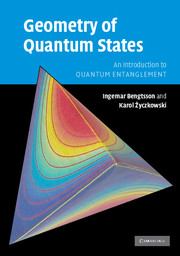Book contents
- Frontmatter
- Contents
- Preface
- 1 Convexity, colours and statistics
- 2 Geometry of probability distributions
- 3 Much ado about spheres
- 4 Complex projective spaces
- 5 Outline of quantum mechanics
- 6 Coherent states and group actions
- 7 The stellar representation
- 8 The space of density matrices
- 9 Purification of mixed quantum states
- 10 Quantum operations
- 11 Duality: maps versus states
- 12 Density matrices and entropies
- 13 Distinguishability measures
- 14 Monotone metrics and measures
- 15 Quantum entanglement
- Epilogue
- Appendix 1 Basic notions of differential geometry
- Appendix 2 Basic notions of group theory
- Appendix 3 Geometry: do it yourself
- Appendix 4 Hints and answers to the exercises
- References
- Index
13 - Distinguishability measures
Published online by Cambridge University Press: 27 August 2009
- Frontmatter
- Contents
- Preface
- 1 Convexity, colours and statistics
- 2 Geometry of probability distributions
- 3 Much ado about spheres
- 4 Complex projective spaces
- 5 Outline of quantum mechanics
- 6 Coherent states and group actions
- 7 The stellar representation
- 8 The space of density matrices
- 9 Purification of mixed quantum states
- 10 Quantum operations
- 11 Duality: maps versus states
- 12 Density matrices and entropies
- 13 Distinguishability measures
- 14 Monotone metrics and measures
- 15 Quantum entanglement
- Epilogue
- Appendix 1 Basic notions of differential geometry
- Appendix 2 Basic notions of group theory
- Appendix 3 Geometry: do it yourself
- Appendix 4 Hints and answers to the exercises
- References
- Index
Summary
Niels Bohr supposedly said that if quantum mechanics did not make you dizzy then you did not understand it. I think that the same can be said about statistical inference.
Robert D. CousinsIn this chapter we quantify how easy it may be too distinguish probability distributions from each other (a discussion that was started in Chapter 2). The issue is a very practical one and arises whenever one is called upon to make a decision based on imperfect data. There is no unique answer because everything depends on the data – the l1-distance appears if there has been just one sampling of the distributions, the relative entropy governs the approach to the ‘true’ distribution as the number of samplings goes to infinity, and so on.
The quantum case is even subtler. A quantum state always stands ready to produce a large variety of classical probability distributions, depending on the choice of measurement procedure. It is no longer possible to distinguish pure states from each other with certainty, unless they are orthogonal. The basic idea behind the quantum distinguishability measures is the same as that which allowed us, in Section 5.3, to relate the Fubini–Study metric to the Fisher–Rao metric. We will optimize over all possible measurements.
Classical distinguishability measures
If a distance function has an operational significance as a measure of statistical distinguishability, then we expect it to be monotone (and decreasing) under general stochastic maps. Coarse graining means that information is being discarded, and this cannot increase distinguishability.
- Type
- Chapter
- Information
- Geometry of Quantum StatesAn Introduction to Quantum Entanglement, pp. 323 - 338Publisher: Cambridge University PressPrint publication year: 2006



